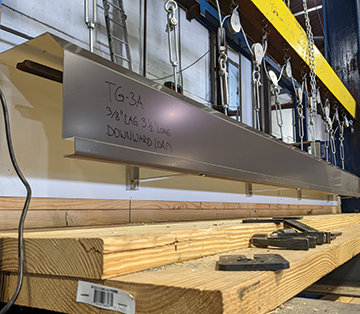
NRCA has conducted testing of metal roof edge gutters according to ANSI/SPRI GT-1-2016, “Test Standard for Gutter Systems.” If you design, shop fabricate and/or install gutters for low-slope membrane roof systems, you should be aware of ANSI/SPRI GT-1, the building code requirement that requires gutter testing, and NRCA’s gutter testing and certification programs.
ANSI/SPRI GT-1
ANSI/SPRI GT-1 provides a methodology for testing static load resistances of exterior hanging gutters used with low-slope roof systems. Gutter resistances are tested in three directions as shown in the figure.
Test G-1 tests a gutter’s resistance to a horizontal outward load, such as an outward wind load. Test G-2 tests a gutter’s resistance to a vertical upward load, such as an upward wind load. Test G-3 tests a gutter’s resistance to a downward load, such as the weight of water, snow and ice.
The test method does not assess a gutter’s water-carrying capacity or water removal.
ANSI/SPRI GT-1 was developed and is promulgated as a national consensus standard by SPRI Inc. The test standard can be downloaded for free from spri.org.
Code requirement
The International Building Code,® 2021 Edition, includes the following requirement specific to gutters: “1504.6.1 Gutter securement for low-slope roofs. Gutters that are used to secure the perimeter edge of the roof membrane on low-slope (less than 2:12 slope) built-up, modified bitumen, and single-ply roofs, shall be designed, constructed and installed to resist wind loads in accordance with Section 1609 and shall be tested in accordance with Test Methods G-1 and G-2 of SPRI GT-1.”
The code requires gutters’ tested resistances to be greater than their buildings’ design wind loads, which typically are determined using ASCE 7-16, “Minimum Design Loads and Associated Criteria for Buildings and Other Structures.” The code doesn’t specifically require a safety factor be applied to tested resistances; however, use of a safety factor of 2.0 is good practice when using the allowable stress design method.
The code’s gutter testing requirement is more limiting than ANSI/SPRI GT-1’s scope and specifically applies to exterior perimeter edge gutters used with built-up, polymer-modified bitumen or single-ply membrane roof systems installed at less than 2:12 slope. Also, ANSI/SPRI GT-1’s GT-3 downward resistance test does not apply to the code’s requirement.

NRCA testing and certification
NRCA has tested a limited number of gutter profiles and materials using ANSI/SPRI GT-1.
NRCA tested five, Style D exterior 6- and 8-inch-wide gutter profiles fabricated from galvanized steel and aluminum using exterior gutter brackets or internal stiffeners depending on gutter size and material.
The results of NRCA’s testing are provided in the shop-fabricated edge metal flashings section of nrca.net.
NRCA also has obtained and maintains third-party certifications for compliance with ANSI/SPRI GT-1 by UL Solutions and Intertek Testing Services based on this testing. Additional information about these certifications is available in UL’s Product iQ® and Intertek Testing Services’ SpecDIRECT™ applications, respectively.
Closing thoughts
NRCA is conducting additional testing and maintains its UL and Intertek Testing Services certifications to provide roof system designers with baseline data and fabricators and installers a means of complying with IBC 2021’s requirements for gutters.
Additional information about shop-fabricated architectural metal flashings, including gutters, is provided in the Architectural Metal Flashing Section of The NRCA Roofing Manual: Architectural Metal Flashing and Condensation and Air Leakage Control—2022, which can be purchased or is available as a free member download at shop.nrca.net.
MARK S. GRAHAM is NRCA’s vice president of technical services.
@MarkGrahamNRCA
This column is part of Research + Tech. Click here to read additional stories from this section.



